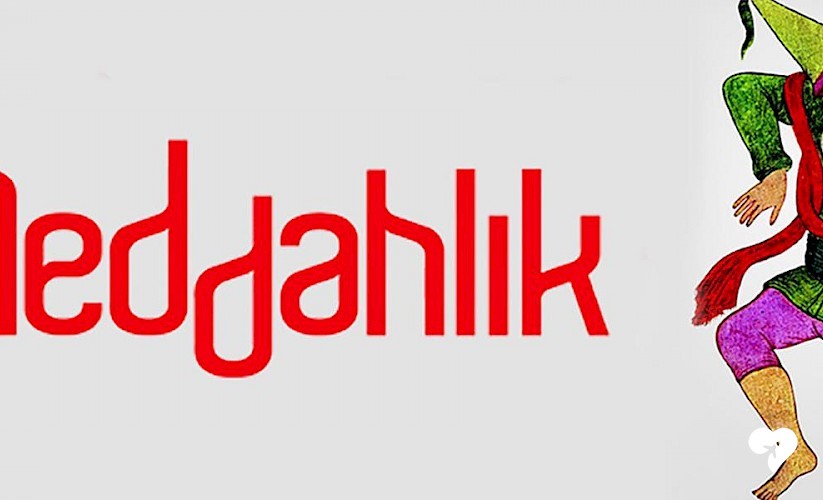The Art of the Meddah (Public Storytelling) may be described as the art of telling stories for the purpose of entertaining an audience with impersonations and animation. Those who practice this art are called meddah from metheden, the Arabic word for "one who praises".
The meddah sits on a chair while performing his art and does impersonations and animations during his story using accessories such as a staff (pastav) and handkerchief (makreme). The staff is not only used as a sound effect to get the attention of the audience and strengthen the expressions, but also to represent objects or living things. The handkerchief, on the other hand, is used to alter voices or represent a different character. There are also historical records indicating that these objects used in meddah performances have symbolic meanings within the meddah tradition.
The meddah tale begins by striking the staff on the floor three times and saying, "Truth, my friend, truth" and reciting a rhyme. In order to prevent anyone from being offended due to the names of persons or places, the storyteller will say, "One name is like another, the same is true of orphans and neighbourhoods. A tale of the past is told, a lie is heard as truth, and thus the time is passed". He occasionally pauses in the narrative to help the audience understand and interpret the story. Sometimes, he stops at the most exciting part and collects money from the audience. He finishes his performance by saying, "forgive us for any slips of the tongue".
The storytellers may address a variety of legends, tales, historical events and persons as well as scenarios and contexts that allude to current social or political events. Therefore, social and political criticisms can be expressed either openly or through allusions made to the audience via scenarios or contexts. It is for this reason that these storytellers are characterized as a mirror of the social, political and economic conditions of their time. In this respect, the performances of the storytellers come close to modern epic theatre.
The Art of the Meddah is one of the few surviving types of Traditional Turkish Theater and entertaining arts. The meddah performances are usually an improvisation based on the audience profile, and their interests, as well as current social and political events. In this respect, almost every performance is unique and original even though it has a certain scenario and system. The fact that the meddah tradition is kept alive through oral narratives in a master-apprentice relationship has made it difficult for the stories to survive, so there are very few published meddah texts. In the past, meddah storytellers would perform their arts at the palace, in mansions, at circumcision parties and coffee houses, but today they perform mostly during the month of Ramadan, on religious holidays, on television programs and various stages. These changes in the location and time of the performances, and the contemporary scenarios and contexts of the stories have led to the emergence of examples that are described as modern meddah.
Prof. Dr. Nurhan Tekerek, Sinan Bayraktar, Ahmet Yenilmez and Uğur Uzunok have authored many remarkable works in this area. Even though the number of artistic works, events and activities directly associated with meddah storytelling in Turkey may be viewed as small, the Art of Meddah is included in the Traditional Turkish Theater category at theater and comedy festivals, celebrations and on matinee programs. Furthermore, meddah courses are taught in fine arts departments, conservatory and theater departments, and in theater programs organized in cooperation with municipal governments and civil society organizations for the purpose of keeping the tradition alive.
The Ministry of Culture and Tourism continues to conduct research, identification and inventory work on the meddah tradition in order to transmit to future generations this unique heritage, which is on the verge of disappearing. After the meddah tradition was registered on the List of Masterpieces of the Oral and Intangible Cultural Heritage of Humanity, the International Symposium of action plan based on these discussions was drawn up.
After the tradition was added to UNESCO's Representative List of the Intangible Cultural Heritage of Humanity in 2008, the Art of the Meddah Workshop was held in Ankara December 20-25, 2010, where problems faced by this element and possible solutions were discussed with experts, academicians and artists and a second action plan based on these discussions was drawn up.
As part of the action plan, a DVD accompanied by a booklet was published using meddah performances from modern meddah storytellers Prof. Dr. Nurhan Tekerek, Sinan Bayraktar and Ahmet Yenilmez and reenactments of meddah performances from the TRT archives were executed by Erol Günaydın, Münir Özkul, Gazanfer Özcan and Hakkı Karadayı. The Art of Meddah Tradition was included among the Masterpieces of the Oral and Intangible Cultural Heritage of Humanity in 2003, and was added to UNESCO's Representative List of the Intangible Cultural Heritage of Humanity in 2008.
